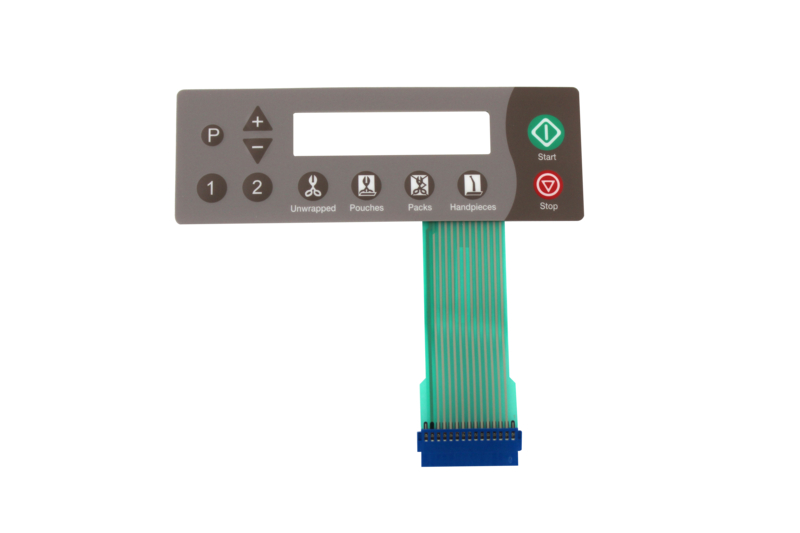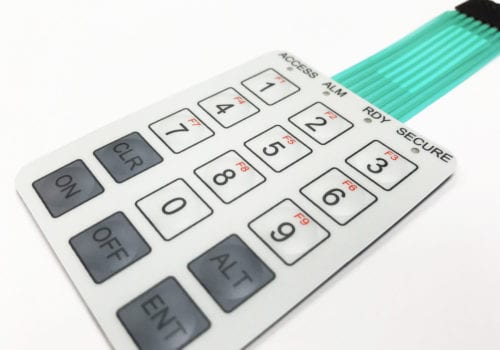Choosing a domestic membrane switch manufacturer can reduce lead times and delivery costs.
Choosing a domestic membrane switch manufacturer can reduce lead times and delivery costs.
Blog Article
All About Membrane Layer Change: Understanding Its Layout and Performance
When you believe about the control user interfaces in modern-day devices, membrane buttons frequently come to mind. Allow's discover what collections membrane changes apart from other control systems.
What Are Membrane Layer Buttons?

Their seamless nature makes them easy to clean and resistant to dust and moisture, a crucial feature in numerous environments. Membrane buttons can also be personalized concerning form, dimension, and graphics, enabling suppliers to develop special interfaces customized to particular items. Plus, they're lightweight and thin, which aids in reducing the general bulk of tools. Overall, membrane layer switches play a considerable role in enhancing individual experience throughout a large selection of applications.
Exactly How Membrane Layer Switches Job
When you press a secret on a membrane layer button, it triggers an uncomplicated yet reliable system. The leading layer, commonly constructed from flexible product, pushes down onto a conductive layer beneath it. This activity bridges the void in between conductive traces, finishing an electrical circuit. As quickly as the circuit closes, it sends out a signal to the gadget's controller, which interprets your input.
You'll see that the responsive comments differs based on the button design, offering either a soft click or a more obvious action. As soon as you launch the trick, the membrane layer returns to its initial placement, reopening the circuit and quiting the signal. This procedure takes place practically instantaneously, ensuring a receptive customer experience.
Membrane switches are prominent as a result of their longevity and resistance to dirt and dampness, making them excellent for various applications, from home appliances to medical gadgets. Recognizing this procedure aids you value their prevalent use.
Trick Components of Membrane Buttons
Comprehending the essential elements of membrane switches is essential for comprehending their functionality and style. At the core, you'll locate the graphic overlay, which gives the visual user interface for users. Below that, there's a spacer layer that divides the circuit layers, guaranteeing that they don't make get in touch with till pressed. The circuit layer is where the magic takes place; it consists of conductive traces that complete the circuit when you press the switch. An additional important aspect is the glue backing, enabling the button to comply with surface areas safely. The safety layer guards against environmental variables and wear, expanding the switch's lifespan. Each element plays a substantial role in making certain trusted efficiency and individual communication. By recognizing these components, you'll get insight right into just how membrane layer changes run and their relevance in various applications.
Materials Used in Membrane Layer Change Design
The performance and sturdiness of membrane layer switches greatly depend upon the products used in their style. You normally come across polyester and polycarbonate as primary substratums due to their superb stamina and versatility. These products withstand scrapes and chemicals, making them excellent for demanding environments.
The conductive layers usually utilize silver or carbon, chosen for their reliability and conductivity. membrane switch manufacturer. Silver gives exceptional performance, while carbon is an economical choice. For the overlay, you may take into consideration a matte or glossy finish, relying on your visual demands and customer experience
Make certain to select adhesives that withstand environmental aspects like temperature level and humidity. Selecting the best materials will certainly guarantee your membrane layer button stands the test of time.
Layout Considerations for Membrane Layer Buttons
While developing membrane buttons, it's important to take into account numerous aspects that influence their functionality browse around this site and individual experience. Begin by focusing on the layout and button size; ensure they're intuitive and simple to navigate. Consider the responsive feedback you intend to provide-- will users need a recognizable click or a softer touch? Additionally, consider the materials you'll utilize, as they'll affect durability and appearances.
Confirm your layout suits ecological elements, like wetness or temperature level variations, which can impact performance. By carefully considering these components, you'll develop a membrane layer button that enhances use and contentment.
Applications of Membrane Switches
Membrane layer buttons are functional components discovered in different applications, from commercial tools to customer electronic devices. You'll see their influence in equipments that require durable interfaces and in tools that gain from smooth layouts. Recognizing these applications aids you appreciate the performance and practicality of membrane switches in daily technology.
Industrial Tools Usage
When you're looking to boost the performance of industrial tools, membrane buttons use a reputable remedy that combines sturdiness with straightforward layout. These switches are perfect for severe atmospheres, giving resistance to dirt, dampness, and chemicals. Accept membrane switches to streamline your procedures and improve overall performance.
Consumer Electronics Integration
In the domain of customer electronics, membrane layer buttons play an important role in boosting user communication and gadget functionality. Membrane layer switches additionally guarantee durability and resistance to dirt and moisture, expanding the life-span of your electronics. By selecting membrane layer buttons, you improve not just the performance but also the design of your devices, making day-to-day interactions smooth and pleasurable.
Benefits and Drawbacks of Membrane Layer Switches
While membrane layer switches offer an array of benefits, they also come with some downsides that you need to consider. One considerable benefit is their small layout, making them perfect for space-constrained applications.

However, there are disadvantages. Membrane layer buttons can have a shorter life-span compared to mechanical switches, specifically under heavy use. They can additionally be less responsive, which may impact individual comments throughout operation. If damaged, fixing them can be tough and commonly needs complete substitute. Inevitably, their sensitivity to severe temperature levels and ecological problems might limit their performance in particular settings. Stabilizing these pros and disadvantages will certainly aid you determine if membrane layer buttons are the best suitable for your project.
Regularly Asked Concerns
How Lengthy Do Membrane Switches Over Typically Last?
Membrane switches typically last in between 5 to 10 years, depending on use and ecological problems. You'll intend to examine aspects like wear, exposure to wetness, and temperature changes to determine their longevity successfully.
Can Membrane Layer Changes Be Custom-made for Details Layouts?
Yes, you can personalize membrane layer buttons to fit specific styles (membrane switch manufacturer). You'll have the liberty to select colors, forms, and formats that match your project's needs, ensuring they mix seamlessly with your general aesthetic
What Is the Price Variety for Membrane Layer Switch Over Production?
The cost variety for membrane useful link layer button manufacturing normally drops in between $1 and $10 per system, depending on variables like style complexity, quantity, and products. You can obtain quotes from manufacturers to locate the finest choice.

Are Membrane Switches Over Water-proof or Immune?
Membrane layer switches can be designed to be water-proof or resistant, relying on materials utilized and building methods. If you require them for damp environments, guarantee you specify those requirements during the design procedure.
Just How Do Membrane Layer Switches Over Compare to Standard Switches?
Membrane layer buttons are usually thinner and more flexible than traditional buttons, offering a smooth layout. They're typically easier to clean up and incorporate, but may not provide the tactile responses you're used to with mechanical choices.
Verdict

Report this page